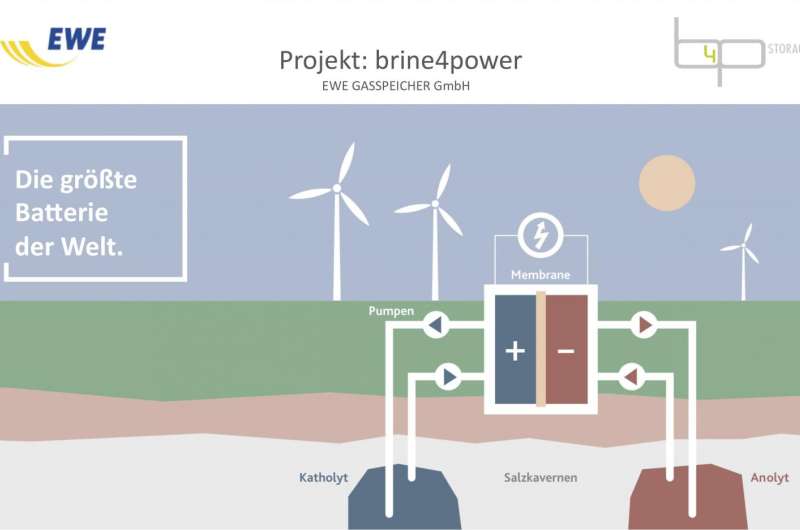July 12, 2017 weblog
Germany: Ambitious project calls for battery housed in underground salt caverns

(Tech Xplore)—A company has an ambitious plan: To build the world's largest battery. Germany is the hatching grounds. Ewe Gasspeicher, subsidiary of utility company Ewe, is talking about its plan with an approach that centers around the redox flow battery principle.
This is where electrical energy is stored in liquid in which certain chemicals are dissolved. These solutions are called electrolytes.
The battery will have components based on salt water and recyclable plastics and developed by the Friedrich Schiller University Jena.
"Electrolytes previously used included environmentally polluting salts of heavy metals such as vanadium dissolved in sulphuric acid. The Friedrich Schiller University in Jena has now developed a redox flow battery that uses recyclable polymers (plastics) dissolved in salt water as an electrolyte."
"Ewe says its invention is a 'green megabattery for green energy,'" wrote Global Construction Review.
The plans call for the world's biggest battery using redox flow technology in underground salt caverns usually used for natural gas storage.
Electrical energy would be stored in a liquid along with "new" components in the underground salt caverns currently used for storing natural gas.
Two caverns, each with a volume of 100,000 m³, will be used for the battery.
The components are the result of the collaboration with the Friedrich Schiller University in Jena, which developed them.
"'Since salt water in caverns is also known as brine and we intend to store power according to the redox flow principle, we have named the project brine4power, or b4p for short,' said project manager Ralf Riekenberg."
According to Global Construction Review, Riekenberg said he assumed they may have a cavern battery in operation at the end of 2023.
Initially, they will not be using actual caverns but enormous plastic containers, said the news release. These will be set up at the gas storage facility in Jemgum in East Frisia, probably in the fourth quarter of this year.
Ewe Gasspeicher GmbH Managing Director, Peter Schmidt: "If everything works, this may fundamentally change the storage market, i.e. the market for control energy."
"Once built," said Global Construction Review, "the batteries would be used to increase the stability of the German grid, thereby allowing it to accept a higher percentage of intermittent generators."
An EW site said that "brine4power is the project for cost-effective, safe and sustainable power storage. In combination with a suitably sized wind farm, each battery replaces a controllable 120-megawatt power plant, supplying constant and clean energy at consistent prices."
If it works, Ewe Gasspeicher will create a 700MWh battery, said Global Construction Review.
Lulu Chang in Digital Trends: "All these caves have a volume of 3.5 million cubic feet, which ought to give the resulting battery a capacity of up to 700MWh at an output of 120MW."
Chang said if it works, the battery ought to be able to supply 75,000 homes with their power for a day.
"While bulkier than lithium-ion battery systems, redox flow systems do not degrade through heavy charge and discharge cycles, meaning they are expected to last many years longer in the field," commented Energy Storage News.
More information:
www.ewe-gasspeicher.de/home/b4p
www.ewe.com/en/media/press-rel … rgest-battery-ewe-ag
© 2017 Tech Xplore


















